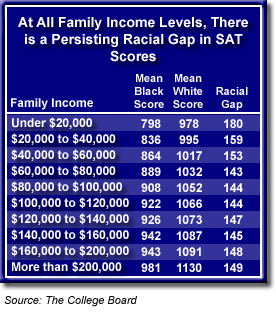



Family Income Differences Explain Only a Small Part of the SAT Racial Scoring Gap
For both blacks and whites, family income is one of the best predictors of a student’s SAT score. Students from families with high incomes tend to score higher. Students from low-income families on average have low SAT scores. Because the median black family income in the United States is about 60 percent of the median family income of whites, one would immediately seize upon this economic statistic to explain the average 200-point gap between blacks and whites on the standard SAT scoring curve.
But income differences explain only part of the racial gap in SAT scores. For black and white students from families with incomes of more than $200,000 in 2008, there still remains a huge 149-point gap in SAT scores. Even more startling is the fact that in 2008 black students from families with incomes of more than $200,000 scored lower on the SAT test than did students from white families with incomes between $20,000 and $40,000.
But the fact is that even when family income levels are similar, we are still comparing black and white students who are as different as apples and oranges in terms of educational sophistication, family educational heritage, family wealth, and access to educational tools and resources. The average white family in the same income group is far better equipped than the average black family to prepare their children for success on the SAT test.

![]()
Copyright © 2009. The Journal of Blacks in Higher Education. All rights reserved.